
 |
Philatelic History of Wilmington, North CarolinaRevised 11/26/2023 |
| (> 1859) Page 1 | (1860-1897) Page 2 | (1898-1916) Page 3 | (1917-1941) Page 4 | (1942-1971) Page 5 | (1972 >) Page 6 |
Philatelic Item |
It is our hope that this web-page will serve to stimulate an interest in the collecting, conservation and documentation of postal history covers of Wilmington.
Wilmington Philatelic Society |
|||
|---|---|---|---|---|
| Year | Pix | Cat # | Description | By |
| Wilmington is a city in New Hanover County, North Carolina, United States.
Wilmington's population surpassed 100,000 in 2006.
Today Wilmington is known as the "Port City" and thrives as a seaport, premier tourist and film-making destination. Visit the Wilmington,NC (WIKI site) Visit the North Carolina Museum of History located in Raleigh. Visit the Cape Fear Museum of History & Science located in Wilmington. |
||||
| 1771 |
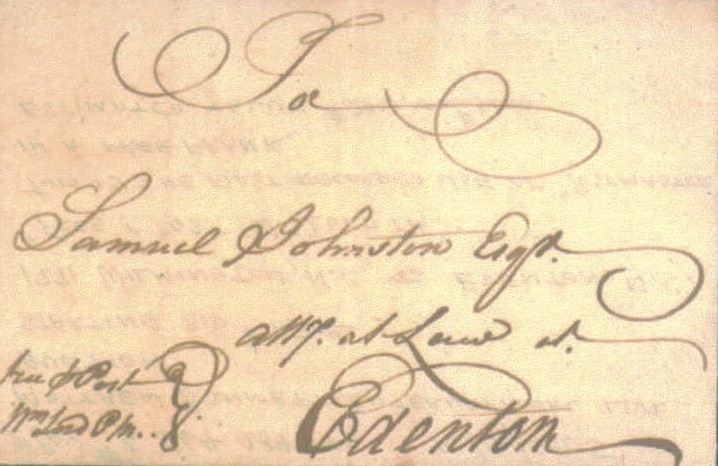
|
--- | A letter sent from Wilmington to Edenton NC (Free P Post - Wm Lord Pm). This is the first recorded use of "Postmaster" as a free frank. | WT |
|
Naval stores and lumber fueled the Wilmington economy both before and after the American Revolution (1775-76). The area was home to several notable Revolutionaries including:
William Hooper, a signer of the Declaration of Independence and
Cornelius Harnett, a member of the Continental Congress.
July 4, 1776 - United States Declaration of Independence was signed. |
||||
| 1798 |

|
--- | A stampless cover sent on July 8, 1798 by Jane Walker from Wilmington NC to John Allen in Philadelphia Pa. Letter content: Walker explains her reasons for being late in making payment for goods that she received. |
GS |
| 1813 |

|
--- | A stampless cover sent on March 27, 1813 by Talcott Burry from Wilmington to Whiteman Burritt, merchant in New York. Letter content: Enclosed I forward you a bill of exchange on John F Brugwin at sixty days sight for eight hundred dollars. I have to request you - when this bill is paid, to pay Mr Mortimer Bradley, one hundred dollars for my account. Leut Cowan arrived in town last evening and is much pleased with the military goods, have not received pay for them yet, but expect to in a few days - flour firm $13.50 to $14 in Charleston and every bunch that has been brought to this market for sometime has been shipped to that place. Master Arnold and myself has made a shipment of 100 bunches to Charleston which we expect to get from $13 to $14 dollars, per bunch. |
RP |
| In 1818 David Smith commenced publication of a Wilmington newspaper, the Cape Fear Recorder. | ||||
| 1829 |
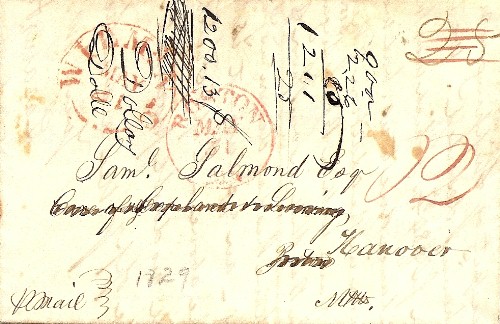
|
--- | A stampless cover sent on May 21, 1829 from Wilmington to Boston MA (25 cents) and then forwarded from Boston to Hanover NH (12 cents). Contents: An Invoive for Cargo being shipped by Lazarus & Whitmarsh on the Brig - Crusader (John Fletcher, the Master). The Invoice total was $1203.97 with the cargo bound for Matanzas (Cuba). | GS |
| In 1832 Henry S Ellenwood established a Wilmington newspaper, the Wilmington Advertiser. Contemporary with this, PW Fanning and Thomas Loring published the People's Press. Later in 1838 Asa A Brown began publishing the Wilmington Chronicle and in 1844 Alfred Price and David Fulton began publishing the Wilmington Journal. Wilmington's population was approximately 5,000 giving it the distinction of being the largest town in North Carolina. | ||||
| 1839 |

|
--- | A stampless cover sent on October 13, 1839 by SM West from Wilmington NC to Law & Todd, merchants in New York NY. SM West was an auctioneer and real estate broker in Wilmington with offices at 9 South Water Street (between Chestnut and Princess Streets). Letter content: SM West was discussing his business relationship with Law & Todd. |
GS |
| 1840 |

|
--- | A stampless cover sent on June 25, 1840 by George French from Wilmington NC to Colonel Richard Borden in Fall River MA.
Letter content: George French wrote a lengthy note concerning a planned shipment of lumber. History: The French House is currently a Bed & Breakfast located at 103 South Fourth Street, Wilmington NC. It is a Greek Revival style house built for George Reade French (1802-1889) who was a native of Fall River MA and a boot and shoe merchant in Wilmington NC. His wife was Sarah Caroline Weeks (1809-1867). The front section of the house was added in 1871 and a Queen Anne style porch installed by 1895 when the original house was moved back on its lot. The house remained in the family for sixty-eight years. It was purchased in 1918 by James Sidbury King (1872-1952) who owned a marble and granite company in Wilmington. King's wife was Evelyn Alexander (1879-1965). The house remained in their family until 1981. The French House is currently operating as a Bed & Breakfast. |
GS |
| 1845 |
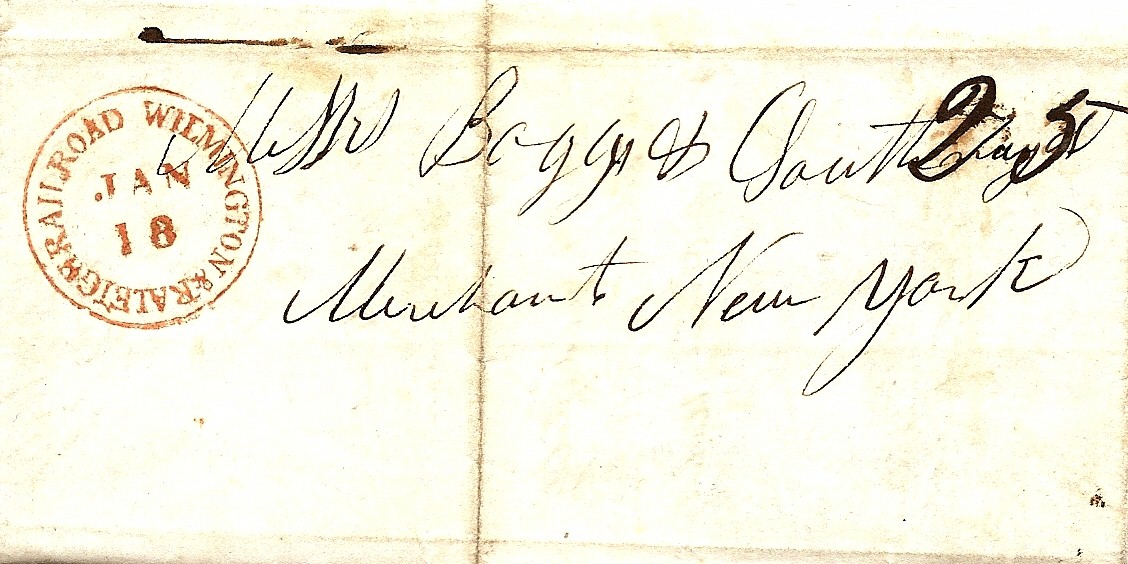
|
--- | A stampless cover cancelled by the Wilmington & Raleigh Railroad on January 18, 1845 and sent to New York (25 cents). History: The first railroad company to operate in North Carolina was the Petersburg Railroad. By 1833 track was laid between Petersburg VA (south of Richmond VA) including nine miles of track near Halifax NC. In December 1937 the Petersburg Railroad crossed the Roanoke River by bridge. The Wilmington & Raleigh Railroad was chartered in 1834 to build its railroad from Wilmington to Raleigh. While it had financial backing from Wilmington residents it did not have the support from Raleigh so the Wilmington stockholders petitioned the legislature in 1836 to change the route to run from Wilmington to Weldon in Halifax County. When completed on March 9, 1840 the Wilmington & Raleigh Railroad was 161 miles long and earned the title of the world's longest railroad. It would connect the city of Wilmington with the Richmond and Petersburg Railroad and the Raleigh & Gaston Railroad a month later in April 1840. North Carolina's state legislature approved the creation of the North Carolina Railroad in 1849. The Wilmington & Raleigh railroad was reorganized in 1851 with state and private ownership and in 1854 was renamed the Wilmington & Weldon Railroad. In January 29, 1856 North Carolina's rail system would become the link between South Carolina's rail system and Virginia railroads over 223 miles of track. Visit the Wilmington Railroad Museum. |
GS |
| Up to 1845 postal rates for a single sheet of paper was 12 1/2 cents and for a double sheet, 25 cents. The first US postage stamps were issued in 1847 but their use was mainly in large cities. Initially the payment of postage was made by the receiver and not by the sender which resulted in a lot of uncalled-for letters. To encourage the use of the post office, postal rates were reduced to 5 cents for a single sheet and 10 cents for a double sheet and stamps were sold for the pre-payment of postage by the sender. The first post office in Wilmington (1846) was located in the old Custom's House.
|
||||
| 1846 |

|
--- | A stampless cover sent on May 6, 1846 by Joseph Clough (who married Eletta V Partridge) from Wilmington NC to Edward Partridge Esq in Prospect ME.
Letter content: He discusses family, health and business; the need for sugar, molasses, sugar and coffee. Had thoughts about getting a vessel and going to the West Indies for more cargo, but is comfortable here and has decided not to go at this time. Health is very good, better than when I left Newburyport MA. As regards my chance for making money, I am satisfied that I can do as well as I thought. This is the hottest day we have had since we have been here - the down east fleet went out this morning and left me all alone. |
GS |
| 1847 |

|
--- | A stampless cover sent on July 23, 1847 by (William) Samuel Shepherd from Wilmington NC to Fisher Blushfield & Company in NYC NY.
Letter content: He discusses a business transaction and that he will send a check "by next mail." Historical information:""James Edward Shepherd (1847-1910), lawyer and jurist, was born at Mintonville, near Suffolk, Virginia, the son of Thomas Swepson Shepherd (1811-1860) and his first wife Ann Eliza Browne (1813-1852). Upon the death of his father, young Shepherd appears to have been put in the care of his much older brother, William Samuel Shepherd (1838-1862), who moved to Murfreesboro, North Carolina. Upon the opening of the Civil War, William S. Shepherd sent his younger brother James back to Suffolk to work as a clerk while he sought and obtained a commission as first lieutenant in Company F., 1st Regiment, North Carolina Infantry. At Suffolk, hating the job of clerk, the not quite fourteen-year-old James claimed to be aged eighteen and joined Company A (composed of Suffolk men), 16th Regiment, Virginia Infantry, as a private. At the end of summer in 1862, Lee's Army of Northern Virginia moved into Maryland during its first invasion of the North. During this campaign young Shepherd revealed the fact that he was aged only fifteen and was discharged from military service near Frederick, Maryland, on September 8. Nine days later his brother, William, was killed at the Battle of Sharpsburg, Maryland. Shepherd saw no further service as a soldier. Instead he spent the remainder of the war as a telegraph operator under contract with the C.S.A. War Department, first at the Narrows of New River in Giles County, Virginia, then at Wilson, N.C. In the meanwhile his sisters, Elizabeth Minton Shepherd and Frances S. Shepherd, who had been living with family members in the Suffolk area, moved to Forest Hill in the mountains of Virginia. The elder of the two, Elizabeth, earned an income by teaching school in both places."" |
GS |
| 1847 |

|
--- | A stampless cover sent on November 30, 1846 by William Giles & Company from Wilmington NC to Fernald & Petigrew (Clipper Shipbuilders) in Portsmouth NH.
Letter content: Letter included a "Bill of Lading" for various quantities and types of lumber. History: Frederick W Fernald and William Petigrew formed Fernald & Petigrew (master Clipper Ship-Builders) on the Piscataqua River in Portsmouth NH. No expense was spared in making these clippers the most ornate marine creations ever built for merchandising purposes. Caught up with the clipper ship frenzy of the 1850s, Fernald & Petigrew built the Red Rover, Water Witch, Dashing Wave, Express Midnight and Express Noonday. |
GS |
| 1849 |
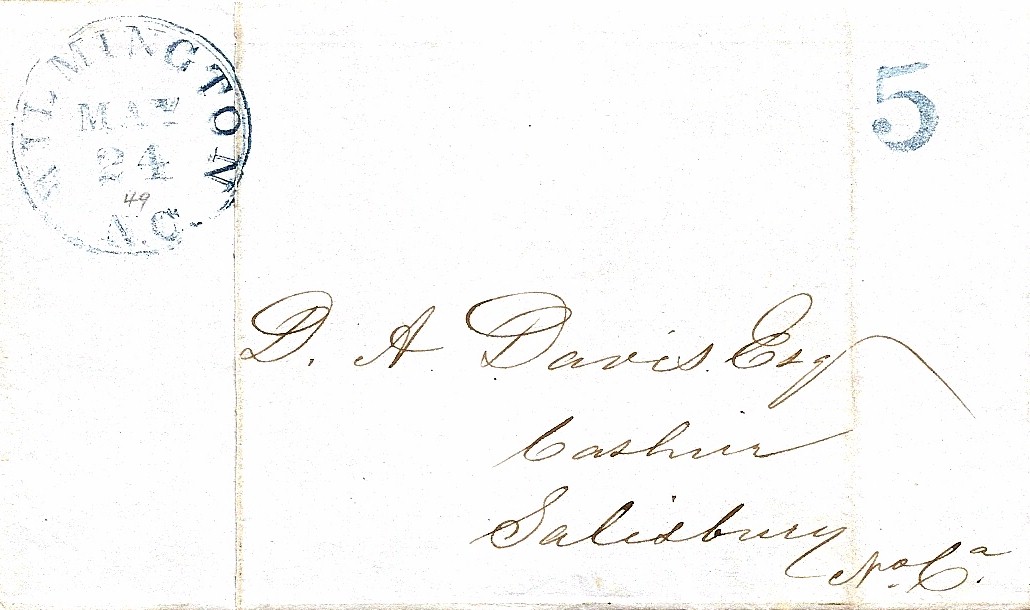
|
--- | A stampless cover cancelled in Wilmington on May 24, 1849 and sent to DA Davis in Salisbury NC (5 cents). It was sent by Henry Russell Savage who was a cashier from 1847 to 1861 in the Wilmington headquarters of the Bank of Cape Fear. During this period Wilmington resident, Thomas Henry Wright was president of this bank.
History: The first banks in North Carolina were chartered in 1804. The Bank of Cape Fear in downtown Wilmington was chartered on December 17, 1804. The Bank of New Bern headquartered in New Bern NC was also chartered in 1804 followed by the State Bank of North Carolina which was chartered in 1810. The Bank of Cape Fear issued more than 50 types of banknotes ($3, $4, $5, $9 & $10) during its existence which ended with the surrender of Wilmington on February 22, 1865. |
GS |
| 1850 |
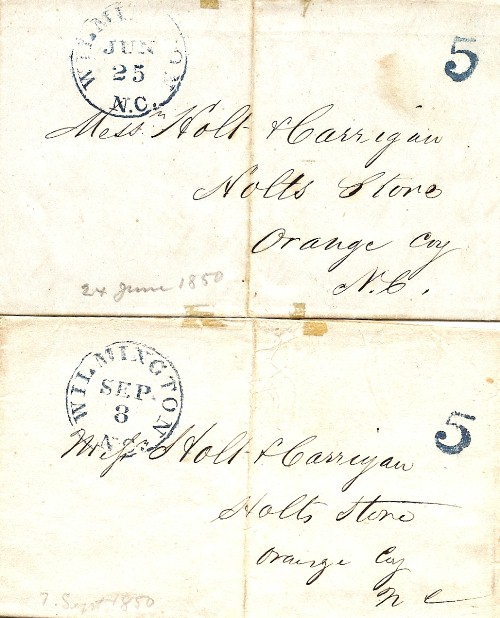
|
--- | Two stampless covers, the first sent on June 25, 1850 & the second sent on September 8, 1850 by DeRosset & Brown to
Holt & Carrigan at Holts Store NC in Orange County. The contents of both letters refer to business transactions regarding the purchase and sale of various goods. History: The DeRosset family descended from French Huguenot, Armand John DeRosset. He immigrated to the American colonies in the 1730s and settled in Wilmington NC where four generations of DeRossets worked as physicians and merchants. Holt & Carrigan were dealers in dry goods, hardware and groceries. They were located in Orange County in the small town of Holts Store. Edwin M Holt was born in 1807. He was one of a family of six children. His father was Michael Holt III who operated a large farm, kept a machine shop, and ran a general store near the village that is now Alamance. In addition, he found time to serve in the State Legislature. Edwin's mother, Rachel Rainey Holt was the daughter of the Reverend Benjamin Rainey, pioneer minister and educator. Edwin grew up in a mixed environment of agriculture, mechanics, merchandising, politics and religion. From his father he inherited an insatiable curiosity and from his mother a keen intellect. He attended the log-cabin village school in winter and helped his father on the farm or in the store in summer. Whenever he could, the boy slipped away to his father's machine shop to watch the making of wheels for one of the farm wagons or the shaping of some part for the grist mill on the Creek. Mechanical things fascinated him. Shortly after his 21st birthday Edwin married Miss Emily Farish, the daughter of a prosperous Chatham County farmer. He built a home, "Locust Grove" on the plantation where his ancestors had fought the Battle of Alamance. The Holt's had ten children. A traveler through this area in January 1849 made the following description of the Holt-Carrigan factory: "I left the place of Pyle's Defeat toward noon, and, following a sinuous and seldom-traveled road through a forest of wild crab trees and black jacks, crossed the Alamance at the cotton factory of Holt and Carrigan . . . This factory, in the midst of a cotton-growing country, and upon a never-failing stream, cannot be otherwise than a source of great profit to the owners. The machinery is chiefly employed in the manufacture of cotton yarn. Thirteen hundred and fifty spindles were in operation. Twelve looms were employed in the manufacture of coarse cotton goods . . . " The factory ran successfully under the firm name of Holt and Carrigan until 1851. Mr Carrigan's wife, Nancy Holt Carrigan, who was Edwin's sister, died in that year, and shortly afterwards the former partner sold his interest to Edwin and moved with his family to Arkansas. Edwin then wrote to his son Thomas, who was living in Philadelphia, and asked him to come to Alamance to help manage the factory. "In 1853," Thomas Holt later recalled, "there came to our place of business on Alamance Creek, a Frenchman, who was a dyer, and was 'hard up' and out of money, without friends. He proposed to teach me how to color cotton yarns if I would pay him the sum of one hundred dollars and give him his board. I persuaded my father to allow me to accept the proposition and immediately went to work with such appliances as we could scrape up, an eighty gallon copper boiler which my grandfather used for purpose of boiling potatoes and turnips for his hogs; a large cast-iron wash-pot which happened to be in the store on sale at the time. With these implements I learned my A.B.C.'s in dyeing. "As speedily as possible we built a dye-house and acquired the necessary utensils for dyeing. The Frenchman remained with me until I thought I could manage by myself. I got along very well, with the exception of dyeing indigo blue. Afterwards an expert dyer in blue came from Philadelphia who taught me the art of dyeing in that color. He then put two negro men to work with me. |
GS |
| In 1851 the Wilmington Chronical newpaper became the Wilmington Herald published by Talcott Burr Jr.
|
||||
| 1852 |
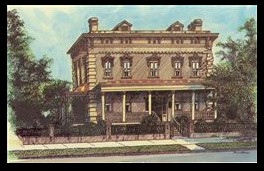
|
--- | A post card (circa 1963) of the Latimer House which was built in 1852 in downtown Wilmington. History: The Latimer House was built in the heart of Wilmington's "Historic District" for local merchant, Zebulon Latimer. His house became the residence of several generations of Latimer’s until 1963 when it became the home of the Lower Cape Fear Historical Society. The Society had been founded in 1956 and was dedicated to the preservation and study of history in the Lower Cape Fear region. The Latimer House is now open to the public as a “house museum” with 14 rooms of historic objects depicting the life of an upper class resident during the last half of the 19th Century. |
OO |
| 1854 |

|
U-10 | A cover sent on January 7, 1854 from Wilmington to Halifax NC. | TB |
| 1855 |
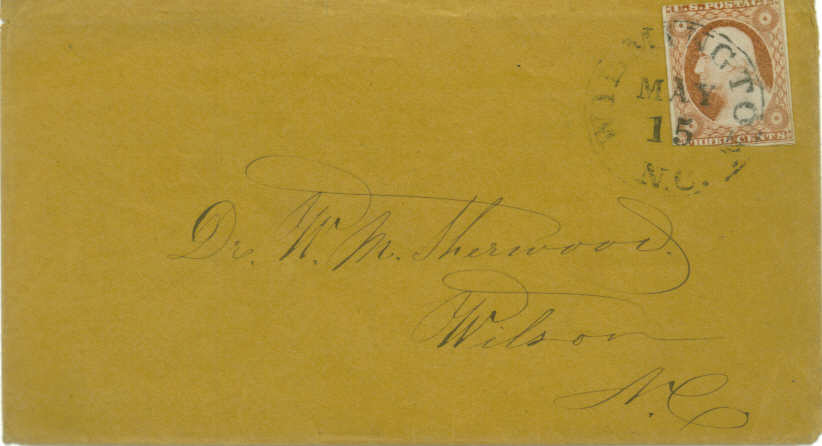
|
11 | A cover sent on May 15, 1855 from Wilmington to WM Sherwood in Wilson NC. | RP |
| 1856 |
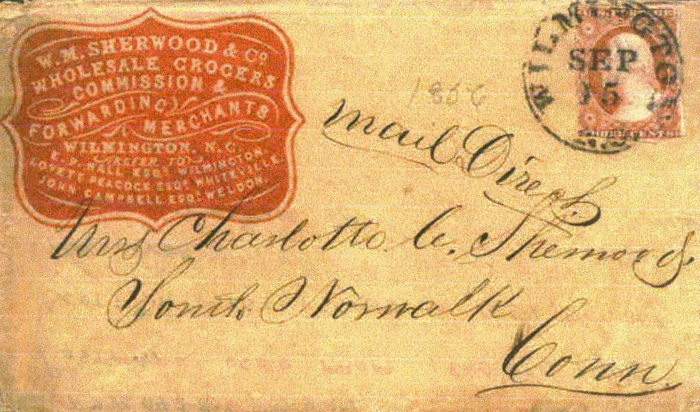
|
11 | A cover sent on September 15, 1856 from WM Sherwood & Co (Wholesale Grocers, Commission & Forwarding Merchants) in Wilmington to Mrs Charlotte Sherwood in South Norwalk CT. Other Commission Merchants | WT |
| 1858 |
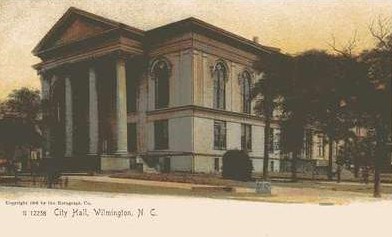
|
--- | A post card (picture circa 1858) of Thalian Hall/City Hall in Wilmington. History: The construction of Thalian Hall was completed in 1858 when Wilmington was the largest city in the state of NC. It is the only surviving theater designed by John Montague Trimble, one of America's foremost 19th-century theater architects. When it opened its doors it housed the town government, the library and an "Opera House" which seated 1,000 people (10% of the population of Wilmington). During the Civil War, Thalian Hall was in almost constant use as a place of amusement. The theater was operated by the early Thalian Association for the first two years of its operation. From 1860 through 1932 Thalian Hall was leased by private entrepreneurs, who booked road shows and star attractions. Between engagements the theater hosted amateur concerts, recitals, meetings, graduations, exhibitions, and even roller-skating. After the turn of the century, Thalian Hall went through several renovations. It had several close calls with demolition in the 1930's and 40's but the citizens of the community always rallied for its preservation. Following a small fire in 1973, the theater was restored to its turn of the century appearance. After reopening in 1975, Thalian Hall witnessed a dramatic increase in use by professional artists and community groups and audience attendance rose. |
OO |
| (> 1859) Page 1 | (1860-1897) Page 2 | (1898-1916) Page 3 | (1917-1941) Page 4 | (1942-1971) Page 5 | (1972 >) Page 6 |